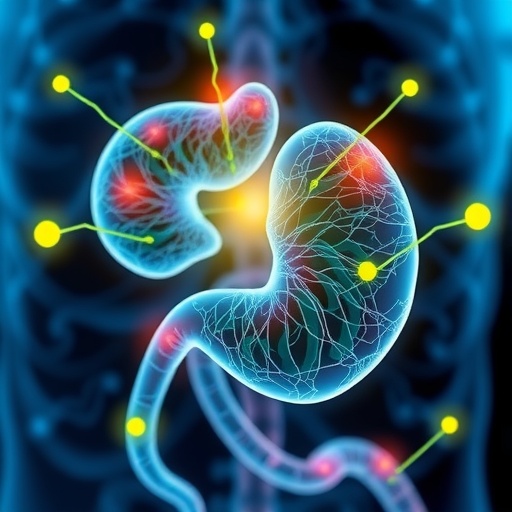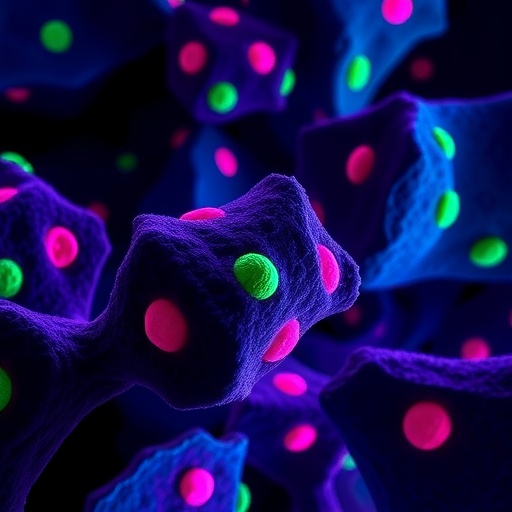Pancreatic cancer remains one of the most lethal malignancies worldwide, notorious for its aggressive nature, late diagnosis, and poor therapeutic outcomes. A groundbreaking study from the Technical University of Munich (TUM) sheds new light on the intricate ways pancreatic tumors manipulate their microenvironment to fuel their growth and metastasis. The research team, led by Professor Ekin Demir, has unveiled a remarkable biological phenomenon wherein pancreatic cancer cells form specialized structures called pseudosynapses to hijack the body’s nervous system signaling, thereby accelerating tumor progression.
The nervous system has long been recognized as a key player in the regulation of various physiological processes, but its role in cancer biology has only recently begun to be understood. Previous work showed that nerves infiltrate tumors—a process termed neural invasion—correlating tightly with worse patient outcomes. However, the TUM team has now taken this knowledge several steps further by investigating whether cancer cells outside the brain mimic neuronal communication mechanisms to promote their own survival and expansion.
Drawing inspiration from studies conducted approximately six years ago demonstrating that some brain tumors establish synaptic connections with neurons to exploit neurotransmitter signaling, Professor Demir’s team hypothesized that similar synapse-like machinery might be present in tumors located outside the central nervous system. Pancreatic ductal adenocarcinoma, known for its dense innervation and frequent neural invasion, emerged as the prime candidate for such an investigation.
The researchers meticulously examined pancreatic tumor biopsies, focusing on receptor populations known for neurotransmitter binding. They discovered a conspicuous enrichment of N-methyl-D-aspartate (NMDA) receptors—ionotropic glutamate receptors typically involved in excitatory neurotransmission within the brain. This finding was striking, because it suggested the tumors were potentially poised to intercept glutamate signals from surrounding nerve fibers.
To confirm whether these NMDA receptors were part of bona fide synapse-like structures, the team employed electron microscopy, a gold standard technique for ultrastructural analysis. The images revealed distinctive formations bearing resemblance to presynaptic and postsynaptic elements. However, these structures deviated in subtle but critical ways from classical neuronal synapses, prompting the researchers to coin the term “pseudosynapses” to describe these tumor-neuron interfaces.
Functionally, the presence of NMDA receptor-enriched pseudosynapses had profound consequences for pancreatic cancer cell physiology. In normal pancreatic tissue, neuronal glutamate release regulates exocrine and endocrine functions through controlled calcium signaling. The tumor cells co-opt this pathway by allowing glutamate to bind their NMDA receptors, which leads to an influx of calcium ions into the cytoplasm. Unlike transient calcium spikes typical of normal cells, cancer cells exhibit slow and sustained calcium waves that trigger oncogenic signaling cascades, fostering rapid proliferation and enabling metastatic dissemination.
This discovery opens a tantalizing avenue for therapeutic intervention. In preclinical mouse models harboring pancreatic tumors, pharmacological blockade of NMDA receptors markedly slowed tumor growth and metastasis formation. Consequently, treated animals showed a significant extension in survival compared to controls. These findings underscore the clinical potential of targeting neurotransmitter-receptor interactions within the tumor microenvironment, a strategy distinct from conventional cytotoxic or targeted therapies.
Seeking translational relevance, the TUM group is now leveraging advanced bioinformatics approaches to repurpose existing pharmaceuticals. By screening drug libraries for compounds capable of inhibiting NMDA receptors in pancreatic cancer cells, they aim to rapidly progress promising candidates into clinical testing. This strategy not only accelerates drug development timelines but may also help to circumvent the notorious chemoresistance and toxicity issues faced with current treatments.
Beyond pancreatic cancer, the concept of pseudosynapse formation may represent a universal mechanism employed by diverse malignancies to exploit their innervation for growth advantage. The presence of such neuron-cancer communication axes broadens our understanding of tumor biology, shedding light on the complex cross-talk that occurs between the nervous system and cancer cells. This paradigm shift offers an exciting frontier for cancer research and the development of neuromodulatory therapies.
Professor Demir emphasizes the pioneering nature of this discovery, stating, “Our data reveal a previously unrecognized modality through which pancreatic tumors co-opt neuronal signaling to drive their progression. Targeting these neuron-to-tumor connections promises innovative strategies that could transform the bleak outlook faced by pancreatic cancer patients.”
The meticulous work presented in this study exemplifies the power of interdisciplinary research, combining neurobiology, oncology, and advanced imaging to unravel the cellular and molecular interplays underpinning one of the deadliest cancers. It challenges the traditional compartmentalization of cancer as a purely genetic disease by highlighting the crucial influence of physiological systems in shaping tumor behavior.
As the scientific community awaits the clinical translation of these findings, this discovery underscores the importance of investigating the tumor microenvironment beyond cancer cells alone. Interrogating the intricate communication between nerves and tumors may well catalyze a new era in precision oncology wherein the nervous system is recognized as both a regulator and therapeutic target in cancer.
The full results of this compelling investigation have been published in the high-impact journal Cancer Cell, further cementing the significance of this discovery within the oncology research landscape. Additional studies will undoubtedly explore the biochemical details and signaling pathways downstream of NMDA receptor activation in cancer cells, as well as the potential synergistic benefits of combining NMDA receptor blockade with existing therapeutic modalities.
In summary, pancreatic tumors do not merely passively exist within a complex microenvironment; rather, they actively engineer specialized pseudosynaptic junctions to hijack glutamatergic neurotransmission. This fuels calcium-dependent signal transduction pathways that power their malignant growth and dissemination. Blocking these pathways represents a promising frontier in the fight against pancreatic cancer, a disease desperately in need of novel, effective treatment options.
Subject of Research: Animals
Article Title: Sensory neurons drive pancreatic cancer progression through glutamatergic neuron-cancer pseudo-synapses
News Publication Date: 25-Sep-2025
Web References:
https://www.tum.de/en/news-and-events/all-news/press-releases/details?tx_news_pi1%5Baction%5D=detail&tx_news_pi1%5Bcontroller%5D=News&tx_news_pi1%5Bnews_preview%5D=41479&cHash=8059c50c2351b652a36fac718df7642f
References:
Ren et al., “Sensory neurons drive pancreatic cancer progression through glutamatergic neuron-cancer pseudo-synapses”, Cancer Cell (2025). DOI: 10.1016/j.ccell.2025.09.003
Keywords: Pancreatic cancer, pseudosynapses, NMDA receptor, glutamate, neural invasion, calcium signaling, tumor microenvironment, neuron-cancer communication, metastasis, translational oncology, targeted therapy, bioinformatics drug repurposing
Tags: aggressive nature of pancreatic tumorscancer biology and nervous systemlate diagnosis of pancreatic cancerneural invasion and cancer progressionneurotransmitter signaling in tumorspancreatic cancer researchpancreatic tumor growth mechanismsProfessor Ekin Demir research studypseudosynapses in cancersynaptic connections in tumorstherapeutic outcomes in pancreatic malignanciestumor microenvironment manipulation





